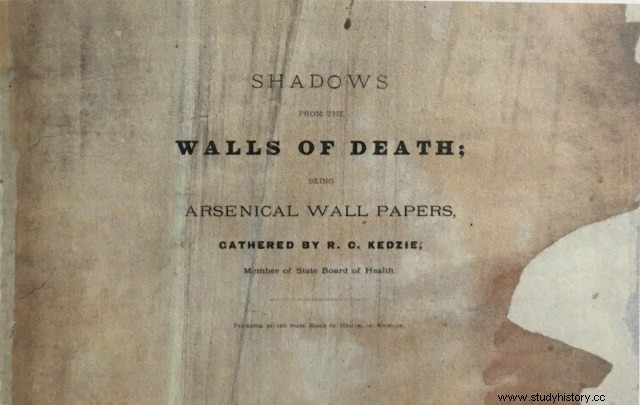Surely when reading the title of this article many of you have thought of the book Ambitions and Reflections -"written" by Belén Esteban- or A new life is possible -"Written" by her ex-mother-in-law Carmen Bazán-. Well no, these, even being pathetic, I think the only thing they can produce is embarrassment and embarrassment. The book I am referring to, Shadows from the walls of death (Shadows of the Walls of Death), is more similar to the movie The Ring (2002), a remake of the Japanese horror film Ringu , where characters watching a videotape received a phone call in which a girl's voice announced that they would die in seven days. Reading or leafing through this book can kill you… literally

Of the 100 copies of the book Shadows from the walls of death that the American physician Robert Kedzie distributed among the libraries of Michigan (USA) in 1874, today only two copies are preserved -one at the University of Michigan (Ann Arbor) and another at the State University of Michigan (East Lansing)- which, moreover, are still potentially lethal. In fact, they are kept in a sealed container and each of their pages is individually encapsulated. Logically, his danger is inside him... but not in the text. Moreover, the only words appear in the prologue, the other 86 pages do not have a single letter and are just pieces of wallpaper strips. The truth is that if we could take a look at it -something that I do not recommend doing without gloves-, we would think we had in our hands a catalog of wallpaper to decorate the walls -surely all of you remember a specific design that in the 70s "decorated" the living room of your house or, worse still, your room. And in one of the components of the wallpaper is the danger... arsenic .

If arsenic is known as the “king of poisons” or the “poison of kings”, it will be for a reason. But why has it been the most widely used poison since ancient times? Because it is tasteless, odorless and soluble, which made it an ideal substance to mix with other foods without raising suspicion (it is estimated that 0.15 grams is the fatal dose for a 75-kilo person). In addition, the symptoms are very similar to very common severe gastrointestinal pathologies, so arsenic poisoning was easy to camouflage (administered in very low doses, it acts slowly but relentlessly). However, it was also used in the past for medical purposes. It is known that Aristotle and Hippocrates prescribed it as a remedy for skin ulcers and, centuries later, syphilis. In addition to being a pesticide, during the 19th century the use of arsenic became widespread, being present in cosmetics and, above all, as a pigment or dye for clothes, labels, playing cards, toys, postcards... all shades of green were due to the treatment with arsenic. Logically, also wallpaper. In fact, a late 19th century study by the American Medical Association estimated that 60% of the wallpaper sold in the US contained arsenic, and of this percentage a third had levels dangerous to health.

Robert Kedzie
And this is where the doctor Robert Kedzie stepped in. . As a member of the Michigan Board of Health, he had studied several cases of poisoning without apparent cause and discovered that the common denominator in all of them was wallpaper. In 1873 he published Poisonous Papers (Poisonous Papers), a report that warned of the danger of the widespread use of arsenic as a pigment for wallpaper. Unfortunately, that complaint was ignored because people were not aware that you did not have to "suck" or touch the walls to get poisoned, with time and humidity the poisonous pigment could form stains or scales, remain suspended in the air or settle on furniture. So, he decided to make a splash to make American society aware that their homes were potentially poisonous. He collected several wallpaper samples directly from acquaintances' houses, cut them into pages, edited Shadows front the walls of death and sent it to 100 Michigan libraries with a report of his studies. In addition, and to give more impact to the awareness campaign, it was invented that a woman had been poisoned after examining the book. Faced with this imminent danger, many libraries directly destroyed the copy that Robert had sent them... and sounded the alarm. Although little by little, from that moment the use of arsenic was replaced and ceased to be a silent and lethal threat disguised in elegant and colorful designs.
Sources:Poison pages, Shadows from the walls of death
